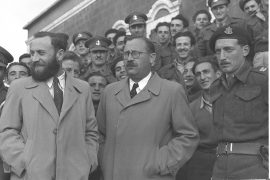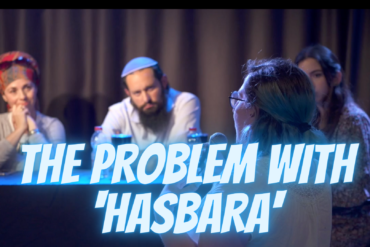As a Jewish therapist, I feel the need to speak out.
What is my narrative as a person with intergenerational trauma? What is the common ground between my maternal grandparents from Europe and my paternal grandparents from the Middle East? What ties it all together is extreme, vile, and vicious Jew hatred.
I have taken it upon myself to find healing and go head-to-head with epigenetic trauma. My narrative is what led me to become a therapist as well as to challenge much of what I thought I knew and rebuild a new narrative. Through this continuous work, I have identified my values and strengths. I have also learned how to identify and work on separating my inherited pain and fear from my essence.
It is no small feat to heal, repair, be strengthened, and feel worthy of life. From the ashes, our people continue to rise. From this place, the battle for justice resumes.
Ye West is a great example of how to apply a narrative therapy lesson.
Let’s start with Externalization. Therapists help clients externalize the story of their lives which helps people to observe themselves. This is what creates distance between the person and their problems.
Externalization allows people to better focus on changing unwanted behaviors. For example, having bipolar disorder isn’t the problem. Bipolar disorder is the problem. One is not defined by their bipolar disorder; their have moments where bipolar disorder symptoms negatively affect them. We can also apply that logic to their behavior. Jewish people existing is not the problem. Saying “Jews,” as in all of us, does not define one’s entire life experiences. They have had some bad experiences with people who happen to be Jews.
Now let’s tap into the lesson of Deconstruction. When a person wants to gain clarity in their story narrative therapy suggests deconstructing it. When stories become problematic, they have a tendency to feel like they are taking over. In this headspace, people tend to make generalized statements and become stuck in a particular story. A narrative therapist would help break down the story into smaller parts to help clarify the problem and make it more approachable.
For example: Your struggle with intergenerational trauma, mental health issues, and the pressures of fame have been extreme on your nervous system. Your nervous system has been out of whack and you can’t think your way out of disregulation. Let’s apply that to your behavior. Your feelings of injustice are taking over your body and when that happens it becomes difficult to cope. Finding a scapegoat for your unhealed trauma and mental health concerns might feel like justice at the moment, but it’s actually creating injustice. By making general statements about Jewish people, you continue to put yourself into a box instead of finding a way to get better.
Finally, we can discuss unique outcomes. When a story feels concrete and immovable, any possibility for an alternative story gets thrown out the window. People can get very stuck in a particular narrative, allowing it to influence several areas of their lives, impacting decision making, behaviors, experiences, and relationships.
As an example; when you say that you “love everyone” what you’re saying is that there is no absolute evil. Essentially, when everything becomes terrible it offers relief from guilt and negative feelings. Let’s now apply this to your behavior. The more you double, triple and quadruple down on your anti-Semitism to relieve deep seeded trauma, the more you lose sight of perspective. Perspective helps you understand other points of view. The more stuck you get in your trauma, the more your decision making, behaviors, and relationships are in danger.
Through narrative therapy, people can identify alternative stories, widen their view of self, challenge old and unhealthy beliefs, and open their minds to new ways of living that feel better and do better. Narrative therapy challenges problematic stories and helps people come to terms with a more accurate and healthier story. This work is vital for people harboring all forms of baseless hatred. And yet, each one of us begins with the same story of a baby in a womb. In that womb, the nervous system begins to learn and be activated.
In order to heal, it is vital to deconstruct the influence of dominant cultural narratives in the antisemites narrative. We need to provide context and education for a new life narrative. It is our job to re-author the story at large. Here are four myths that have been used for centuries to perpetuate anti-Semitism.
Myth 1: Jews killed Christ. This Myth was used to unite Christians. This Myth is one of the origins of anti-Semitism. Consequently, in that century, the Church promoted laws against Jews, barring them from farm ownership, religious worship, and intermarriage.
The preaching of this myth continued for more than 1,600 years. In 1965, a committee of clerics under pope John XXII wrote, Nostra Aetate (“in our time”) that repudiated the ancient Christian’s charge against Jews and reaffirmed God’s eternal covenant with the Jewish people.
Myth 2: Desecration of the host. In 1215, after the church established the doctrine that the flesh and blood of Christ is embodied in the consecrated host & wine used during mass, stories began to circulate that Jews stole, mutilated, or burned the host in order to kill Jesus again.
Over the next 400 years, Jews were burned at the stake or banished from countries in which they lived due to accusations of Host desecration. The last Jews accused of stealing the Host was burned to death in 1631. Accusations of Host desecration gradually decreased after the Reformation.
Myth 3: Blood Libel. This myth is the belief that Jews use the blood of murdered Christian children while baking the Passover matza & other rituals.
Blood libels became increasingly common persisting through the 20th century. The myth was largely responsible for numerous massacres in the Middle Ages as well as pogroms in the 19th century.
A vicious anti-Semitic campaign was launched in the 1800s in the Russian press against the Jewish community. The most notorious blood libel trial took place in 1913 in Kyiv. Nazi propaganda utilized this myth.
The blood libel myth continues to be used in many countries today to promote Jew hatred. It most recently appeared in the Egyptian, Saudi Arabi, and Palestinian press.
Myth 4: The Protocols of the Elders of Zion. One of the most notorious works of anti-Semitic propaganda in modern times is this. It professes that there is a secret Jewish conspiracy for world domination. It is believed to have been written by the Tsarist political police, the propaganda arm of Russia in the 1890s. These protocols were used to incite pogroms against Jews in Russia.
In 1920, the protocols were translated into numerous languages. In 1921, Adolf Hitler referred to these protocols in Mein Kampf. As recently as 2006, these protocols were being printed in England, over the objection of the local Jewish community. The protocols are still advertised in the United States on Amazon. It is important to note that Nazism was spreading across southwest Asia and North Africa. The Nazis collaborated with Islamic leaders in that region who considered the Jewish genocide a form of “divine punishment.”
It is not uncommon for Jewish people to have heard these myths. These false narratives have become internalized by both abusers and the abused. Internalized Jewish oppression is a factor in the narrative of internalized anti-Semitism. Internalized anti-Semitism is a sneaky and undermining phenomenon that affects most, if not all, Jews. I am calling for both anti-Semitic abusers and the abused to “unlearn” and begin to heal these narratives within ourselves. The eradication of nearly 1,700 years of institutionalized anti-Jewish teachings is an ongoing process.
Healing from anti-Semitism will require healing in our bodies as well.
“New advances in psychobiology reveal that our deepest emotions – love, fear, anger, dread, grief, sorrow, disgust, and hope – involve the activation of our bodily structures. The structures – a complex system of nerves – connect the brain stem, pharynx, heart, lungs, stomach, gut, and spine. Neuroscientists call this system the wandering nerve or our vagus nerve; a more apt name to call it might be our soul nerve. The soul nerve is connected directly to a part of our brain that doesn’t use cognition or reasoning as its primary tool for navigating the world. Our soul nerve also helps mediate between our bodies activating energy and resting energy. This part of our brain is the lizard brain. Our lizard brain only understands survival and protection. At any given moment, it can issue one of a handful of survival commands: rest, flight, flee or freeze. These are the only commands it knows and the only choices it is able to make.” (Menakem, Resmaa. My Grandmother’s Hands. Central Recovery Press, 2017,p.5.)
Narrative therapy offers a variety of different lessons that helps people externalize, deconstruct and better understand the stories they tell. Humans are storytellers, from hieroglyphics in ancient caves to folklore and blog posts. With good reason, the stories we tell about ourselves are often the most influential. It is important to challenge the stories we believe about ourselves under the hand of extreme hatred. These stories form our belief systems. These beliefs keep baseless hatred lingering around in the deepest corners.
Facing trauma and healing is uncomfortable, but so is refusing to heal. The refusal to heal will look like avoidance, blame, denial, and in my experience, eye rolls from people telling me I’m crazy (for healing). When everything eventually bubbles up, as it always does, the response from the most wounded parts of us ends up being cruel or worse violent. Trauma is a reflex and it is important to understand that it takes time to heal. Healing is not linear, it is worked through slowly over time, which is why it is so important to have a mind-body connection.
Sometimes trauma is a collective experience and thus a need for communal and collective healing. If we just admit to ourselves that there is trauma in our DNA, the Divine Source opens doors.
“Uncontrollable events in our lives can conspire as if by divine serendipity, to bring us back to shelymut (our whole selves). Sometimes an unwitting stranger may convey an important spiritual message to us through something mundane that she communicates, or an unexpected occurrence may awaken forgotten memories. One day, on a walk around his neighborhood, a client of mine was attacked by a Pitbull for no apparent reason. The powerful rage he felt after the assault helped him get in touch with a repressed, traumatic childhood memory of having being attacked by a group of older children while walking home from school. The rage he felt towards the dog that attacked him helped him connect with feelings he was previously unable to access in therapy. Incidents like this suggest that when we are open to the flow, our inner and outer lives operate almost in unison to awaken us and restore us to our shleymut, or whole selves.” (Frankel, Estelle. Sacred Therapy. National Geographic Books, 2005,p.134)
We now understand how intergenerational trauma is passed down. A repeated release of stress hormones affects a fetus growing in a womb and unhealed trauma may produce sperm with altered DNA expression. We must also remember that intergenerational resilience and grit are passed down as well. We must utilize these strengths to heal and metabolize our pain for ourselves and for our children and grandchildren.
The Hebrew word for wholeness, shleymut, comes from the same root as Shalom, peace. May your search for shelymut bring peace to your nervous system, soul nerve & beyond. May you be blessed to find your strength, resilience, and grit.
(Originally published at the author’s personal blog)





